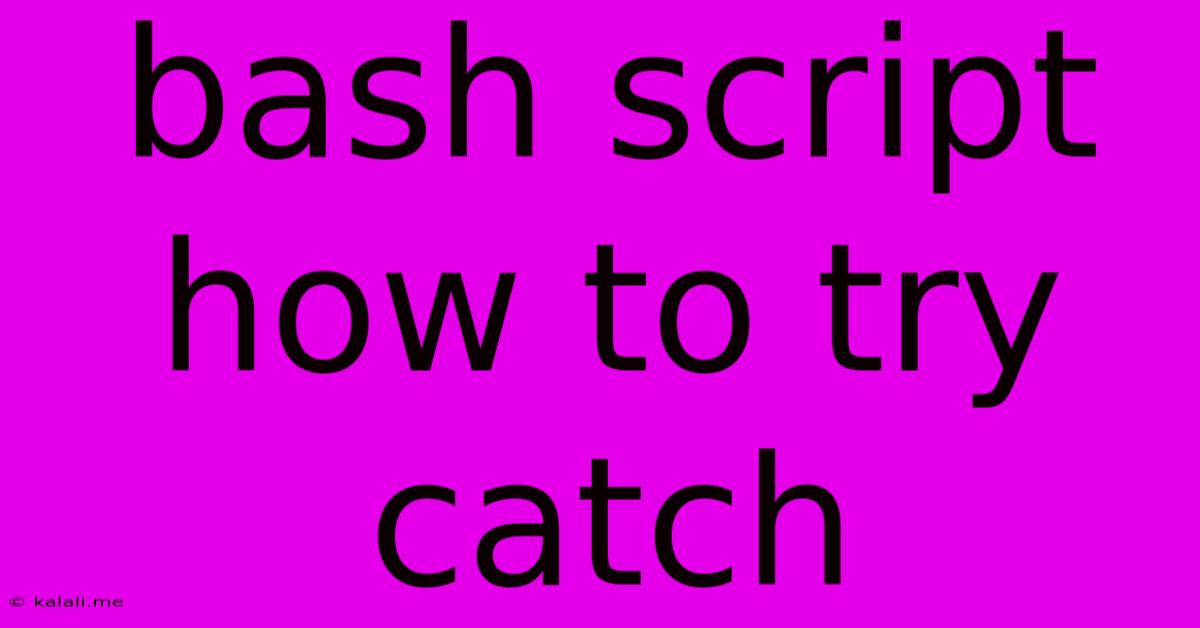Bash Script How To Try Catch
Kalali
Jun 04, 2025 · 3 min read

Table of Contents
Bash Script: How to Implement Try-Catch Functionality
Bash scripting doesn't offer a direct "try-catch" mechanism like languages such as Java or Python. However, we can effectively mimic this functionality using a combination of techniques focusing on error handling and conditional logic. This article explores different approaches to achieve robust error handling in your Bash scripts, effectively creating a "try-catch" like experience. This guide covers several methods, from simple checks to more sophisticated error trapping. Learn how to gracefully handle unexpected situations and prevent your scripts from crashing.
Understanding the Need for Error Handling
Before diving into techniques, it's crucial to understand why error handling is essential. Without it, a single error in your script can lead to its termination, potentially leaving unfinished tasks or corrupting data. Robust error handling ensures your scripts are resilient, providing informative feedback and allowing for graceful recovery or alternative actions when things go wrong. This is particularly important for scripts running unattended or as part of larger automation processes. Key benefits include preventing script crashes, improving stability, and providing better user experience through informative error messages.
Method 1: Using $? (Return Value of Commands)
The simplest method utilizes the special variable $?, which holds the exit status of the previously executed command. A status of 0 typically indicates success, while non-zero values signify errors.
# Try block
command_to_execute
# Check the exit status
if [ $? -ne 0 ]; then
# Catch block: Handle the error
echo "Error executing command_to_execute. Exit status: $?"
exit 1 # Or take other appropriate action
fi
echo "Command executed successfully."
This approach works well for simple commands, but it can become cumbersome for complex operations involving multiple commands where pinpointing the source of the error might be challenging.
Method 2: || (OR) Operator for Simple Error Handling
The || operator provides a concise way to execute a command only if the preceding command fails. This is a streamlined approach for handling simple errors.
# Try block (command that might fail)
command_to_execute || {
# Catch block: Handle the error
echo "Error executing command_to_execute"
exit 1
}
echo "Command executed successfully or error handled gracefully."
This method is compact and readable, ideal for situations where a simple error check is sufficient.
Method 3: set -e (Exit on Error) Option
The set -e option causes the script to exit immediately upon encountering a command that returns a non-zero exit status. While not a direct "try-catch," it enforces strict error handling, ensuring that errors don't propagate silently.
set -e
# Commands within this block will cause the script to exit if they fail.
command1
command2
command3
echo "All commands executed successfully (if no errors)."
Remember to unset -e (set +e) when you need to allow certain commands to fail without stopping the entire script.
Method 4: More Complex Error Handling with Functions
For more sophisticated error handling, particularly in larger scripts, encapsulating code blocks within functions offers better structure and modularity.
my_function() {
# Try block
command1 || return 1
command2 || return 1
command3 || return 1
echo "Function executed successfully"
return 0
}
my_function
if [ $? -ne 0 ]; then
# Catch block
echo "An error occurred within my_function"
exit 1
fi
This approach allows for localized error handling and makes it easier to manage errors within specific parts of your script.
Choosing the Right Approach
The optimal method depends on the complexity of your script and the level of error handling required. For simple scripts, the $? check or || operator might suffice. For larger, more complex scripts, using functions and set -e (carefully) offers a more robust and maintainable solution. Remember that clear, informative error messages are crucial for debugging and understanding issues within your script. Always prioritize providing enough context in your error messages to help identify the root cause of the problem. This improves the maintainability and debuggability of your scripts.
Latest Posts
Latest Posts
-
Signed Pearl Harbor Childrens Book Value
Jun 06, 2025
-
Stardew Does Tiller Work In Multiplayer
Jun 06, 2025
-
I Would Be Please To Chat With You Or
Jun 06, 2025
-
Is It Safe To Make Soucemap Available In Production
Jun 06, 2025
-
Christ In Us The Hope Of Glory
Jun 06, 2025
Related Post
Thank you for visiting our website which covers about Bash Script How To Try Catch . We hope the information provided has been useful to you. Feel free to contact us if you have any questions or need further assistance. See you next time and don't miss to bookmark.